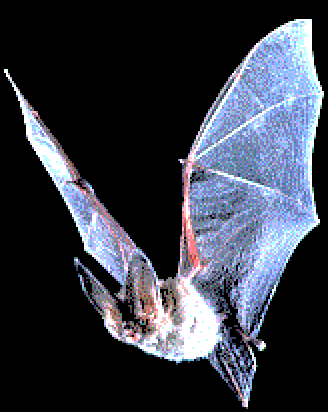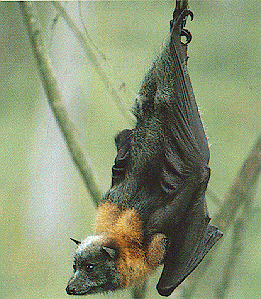 |
 |
|
|
(Grey-headed flying fox) |
CASE STUDY IN MOLECULAR EVOLUTION
NO.
2
Written by Harold B. White, Sept 1995,
revised July 2000
C-667 BIOCHEMICAL EVOLUTION, FALL 2013
 |
 |
|
|
(Grey-headed flying fox) |
Sometimes a comparison of amino acid sequences of orthologous proteins from the groups involved can resolve phylogenetic relationships. The amino acid sequences of the alpha- and beta-globin subunits of hemoglobin from representative micro- and megachiropterans have been determined and compared to those from human (12, 12a, 12b).
Focus Question: If you had the amino acid sequences of the both subunits of hemoglobin from the two types of bats and from humans, how would you go about comparing them? How would you use that information to deduce the phylogenetic relationships among the three organisms? How would you represent the three (or four) possible phylogenies for humans and the two types of bats?
References:
1. Martin, R. D. (1990) Some relatives
take a dive. Nature 345, 291-292.
2. Goodman, B. (1991) Holy phylogeny!
Did bats evolve twice? Science
253, 36.
3. Novacek, M. J. (1992) Mammalian
phylogeny:
shaking the tree. Nature
356,
121-125.
4. Burns, J. J. and Evans, C. (1956) The
synthesis of L-ascorbic acid in the rat from D-glucuronolactone and
L-gluconolactone.
J.
Biol. Chem. 223 897-905.
5. Chatterjee, I. B. (1973) Evolution
and the biosynthesis of ascorbic acid. Science
182, 1271-1272.
6. Pettigrew, J. D. (1986) Flying
primates?
megabats have the advanced pathway from eye to midbrain. Science
231,
1304-1305.
7. Thewissen, J. G. M. and Babcock, S.
K. (1991) Distinctive cranial and cervical innervation of wing muscles:
new evidence for bat monophyly. Science
251,
934-936.
8. Pettigrew, J. D. (1991) Wings or
brains?
Convergent evolution in the origin of bats. Syst.
Zool. 40(2), 199-216.
9. Baker, R. T., Novacek, M. J., and
Simons,
N. B. (1991) On the monophyly of bats. Syst.
Zool. 40(2), 216-231.
10. Pettigrew, J. D. (1991) A fruitful,
wrong hypothesis? Response to Baker, Novacek, and Simmons. Syst.
Zool.
40(2), 231-239.
11. Baker, R. T., Novacek, M. J., and
Simons, N. B. (1991) Approaches, methods, and the future of the
Chiropteran
monophyly controversy: A reply to J. D. Pettigrew. Syst.
Zool. 40(2), 239-243.
12. Kleinschmidt, T., Koop, B. and
Braunitzer,
G. (1986) The primary structure of a mouse-eared bat (Myotis velifer,
Chiroptera) hemoglobin. Biol.
Chem. Hoppe-Seyler 367, 1243-1249.
12a. Singer, G. A., Kleinschmidt, T.,
Pettigrew, J. D., Braunitzer, G. (1991) The primary structure of the
hemoglobin
from the Australian ghost bat (Macroderma gigas,
Microchiroptera).
Biol
Chem Hoppe Seyler 372(12):1089-95.
12b. Kleinschmidt, T., Sgouros,
J. G., Pettigrew, J. D., and Braunitzer, G. (1988) The primary
structure
of the hemoglobin from the grey-headed flying fox (Pteropus
poliocephalus)
and the black flying fox (P. alecto, Megachiroptera). Biol
Chem Hoppe Seyler 369(9):975-84.
Go to:
Page 2:
Using Hemoglobin to Track Blood Lines
Page 3: Reliability of Molecular Phylogenies